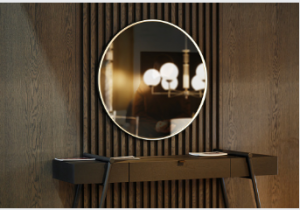Mirrors are objects that reflect light and sound. They also change the direction and angle of light. Therefore, we can see the image in a mirror when we look at it with a lens. This property makes mirrors very useful for reversing an image. However, there are many things we should know before using a mirror.
Reflection of light
Unley-Glass Mirrors are surfaces that reflect light. Light travelling through them reflects at different angles. Therefore, it creates multiple reflections of a single image. However, when viewed from the same direction, the image is distorted. Mirrors are often used in art and architecture. The process of creating a mirror involves a series of geometrical calculations.
 One reason for using mirrors is to increase the amount of light that comes into the room. It makes it possible to visualize reflections and use lighted mirrors to add decor to a room. In addition, they are beneficial in poorly lit areas. Although a mirror cannot increase the intensity of light, the reflection it produces is strong enough to create the illusion of more light.
One reason for using mirrors is to increase the amount of light that comes into the room. It makes it possible to visualize reflections and use lighted mirrors to add decor to a room. In addition, they are beneficial in poorly lit areas. Although a mirror cannot increase the intensity of light, the reflection it produces is strong enough to create the illusion of more light.
A mirror’s surface curvature determines the angle through which a ray of light travels. This angle corresponds to the size of the object that is being viewed. On the other hand, a concave mirror produces a three-fold magnification of an object placed in front of it.
A more sophisticated system is the Mirascope. The Mirascope uses two concave mirrors placed opposite each other. The upper mirror (M2) has a hole in the middle, while the lower mirror (M1) has a slanted surface. The result is an illusion of three-dimensional depth. This process is complicated, and a physical explanation helps understand the phenomenon.
Reflection of sound
A reflection is an effect that happens when sound reaches a solid surface. A flat surface reflects sound waves the same way it reflects light waves. However, a curved surface with an elliptical shape focuses sound waves at a particular point. It can explain the strange acoustics that occurs in large buildings.
The laws of reflection explain the behaviour of sound waves and light. An incident ray hits a mirror at an angle. The reflected wave then re-injects part of the wave into the room. The shape and texture of the surface affect how the sound wave reflects. Rough surfaces tend to scatter energy, while smooth surfaces reflect the light wave coherently.
The laws of reflection apply to light, sound, and seismic waves. Reflection is commonly observed in the surface waves of bodies of water and is a vital concept in sonar. It is also essential in radar and radio transmission. It can also be observed when hard X-rays are reflected from surfaces.
Another effect caused by reflection is reverberation. It happens when sound waves bounce off a mirror or other surface. When this happens, they extend the duration of the sound. Whether this occurs depends on the surface’s size and the sound wave’s length.
Application of mirrors
Mirrors Adelaide is glass panes coated with a metal or other reflective material. The reflective layer is usually a thin layer of metal, although it may be made of other materials with appropriate indices of refraction. This metallic layer makes it possible for people to see through it and can result in a very high reflectivity.
Mirrors come in different shapes and can be manufactured with various engineering tolerances. Tighter tolerances provide better imaging over longer distances and will reduce blur, distortion, and artifacts. However, these types of Mirrors are more expensive than their wider counterparts. Wider tolerances can also be used to produce practical mirrors at lower costs.
Unley-Glass Mirrors are used in many applications, including the automotive industry. They protect drivers and riders from accidents. They also help security personnel monitor hard-to-reach areas. Mirror glass lenses are also used in sunshades to protect the retinas of people exposed to the sun.
If you’re planning to install a mirror in your home, you should know how to place it properly. Mirrors are powerful decorations that can open up a room, and the proper placement will maximize their impact on the lighting. For example, a mirror next to a window will reflect light from the window, making the room appear larger and airier. Positioning a mirror opposite a light fixture or exciting piece of art will achieve the same effect.
